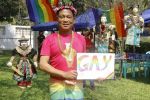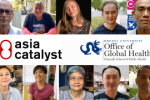By Hye Gi Shim
When a devastating famine hit North Korea in the mid-1990s, hundreds of
thousands of North Koreans were forced to leave their homes and cross the
border into China.
This marked the beginning of a swelling North Korean refugee crisis. Today the Ministry of Unification estimates
that the total number of North Koreans in South Korea is reaching 17,000. As
the problem has grown, the response of South Korean civil society has also
evolved.
People forced from their homes, whether by political
conflicts, discrimination, or economic hardships, are among the world’s most
vulnerable populations. There have been three kinds of response to the
crisis in South Korea.
Some NGOs aim to raise worldwide awareness of the plight
of refugees; others provide direct assistance to North Korean refugees in China; and a third group of NGOs help to resettle refugees who make their way to South
Korea.
Famine Sparks a Refugee Crisis – In the mid-1990s, up to 3
million North Koreans died from starvation, while others escaped to neighboring China
and Russia. International relief
agencies, such as the World Food Program (WFP), UNICEF, and the Doctors Without
Borders (MSF), provided humanitarian aid in North Korea.
Through the Public
Distribution System, however, the North Korean government triaged food
according to political loyalty and proximity to the capital, leaving people in
the peripheral northern provinces
at the mercy of fate. Most of the refugees who fled to China are from those northern provinces, which were most severely
affected by the famine.
Life in China, however,
brought new challenges. Under international convention, someone is
a refugee if he or she, owing to the fear of persecution, is unwilling to
return to the country of his or her nationality. But China,
fearing the influx of refugees from North Korea, considers North
Koreans within its borders “illegal economic migrants.” Once caught, they are
deported back to North Korea,
where they face brutal treatments in concentration camps–under North Korean
law, crossing the border is an act of treason. North Korean refugees are forcibly
returned to North Korea
by the hundreds every week.
As a result, North Koreans in China
are stripped of protection by any government. The refugees, many of them women
and children, are frequently captured by human traffickers at the border and
are forced into marriage or prostitution. Many work illegally and suffer labor
abuses. North Korean orphans roam the streets of bordering Chinese towns
and make their living through begging and stealing. Children
born to North Korean women have no nationality, even when their father is
Chinese, and are denied access to education or health care.
Advocacy and Networking – Some South
Korean NGOs have worked over the years to keep an international spotlight on
the issue. From the mid-1990s and 2004, they called on the Office of the UN
High Commissioner for Refugees (UNHCR) to intervene. UNHCR’s request to inspect
the Chinese-North Korean border, however, was denied by the Chinese
authorities. UNHCR has said that the agency is rendered powerless without the
political will from member states, such as China
and the U.S.
Since then, the momentum for advocacy has shifted to
winning support from key states.
·
The Citizens’ Alliance for North Korean
Human Rights (NKHR) aims to mobilize the international community to focus
on the issue. NKHR hosts annual international conferences, publishes bilingual
periodicals, and runs a comprehensive bilingual website. In September 2006,
NKHR submitted a proposal to the UN Security Council, which was signed by
Vaclav Havel (former president of the Czech Republic),
Kjell Magne Bondevik (former Prime Minister of Norway), and Elie Wiesel (Nobel Peace Prize
Laureate).
·
The director of Helping
Hands Korea, American reverend and long-term Korea
resident Tim Peters, has testified at U.S.
Congressional hearings in 2002, 2004, and 2005
on the suffering of North Korean refugees in China. Rev. Peters had also lobbied
Congress to win the release of activists imprisoned in China for
assisting North Korean refugees. His efforts were reflected in the North Korean Human Rights
Act, which was unanimously approved in both the U.S. Senate and the House
in 2004. The act provides humanitarian and legal assistance to North Korean
refugees and nonprofit organizations working for them.
·
Other groups engage in public protests at home
and abroad to draw attention to the issue.
“The Underground Railroad” – Some South
Korean groups and activists help the refugees safely leave China, which
also refuses to let refugees relocate to a safe third country. These activists
run an underground network of safe houses in China,
Thailand, and Cambodia, helping refugees to seek asylum in South Korea. Durihana Mission, a Seoul-based Christian
NGO led by Rev. Chun Ki-won, is one such group. Unlike their counterparts who
do advocacy, the Underground Railroad groups operate covertly, fearing
political repercussions. Details of such journeys are vividly depicted in the
award-winning documentary, Seoul Train (2004).
Resettlement – Today, there are an estimated 17,000 refugees
living in South Korea.
Roughly 20 percent of them are children and adolescents; many of them have
undergone traumatic experiences during their escape, received little or no
formal education during their time in China, and are simply unfamiliar
with Korean society. Their successful resettlement in South Korea is
a test for the reconciliation of the two nations, which have been separated by
war and ideological differences for six decades. In recent years, South Korean
civil society and government have been increasing efforts to strengthen the
resettlement system.
Until now, resettlement assistance for North Koreans
seeking asylum in the South consisted of a 2-month re-education
in the state-run Hanawon
Center, and an aid package that included a lump
sum of money and a housing subsidy. Long-term assistance, such as education or job
counseling, was not provided in a systematic manner.
Educational prospects for North Koreans in South Korea are particularly grim.
A survey reveals that almost half of North Korean adolescents in South
Korea are not attending school, and, the
dropout rate for those who enter the standard education system is ten times
higher than their South Korean counterparts.
A handful of private institutions provide alternative
schooling for young North Korean refugees, although they are still in short supply.
For example, Yeomyung School is
established and funded by a number of Christian churches; it offers short-term
programs that can substitute for standard middle- and high-school education. Three-four School provides similar
educational opportunities, and incorporates arts and music as a central
program.
The South Korean government is
adding momentum to these efforts. In January 2009, the National Assembly amended
the existing Law on Protection and Resettlement Support for North Korean
Defectors, increasing educational funding. At a policy
discussion session on September 22, 2009, NGOs, scholars, and policymakers spoke
on the topic of alternative education for North Korean adolescents, debating
the challenges for their adjustment in the South and proposing the
establishment of a boarding school that can provide extensive counseling and
build a sense of community.
Rev. Chun Ki-won recently said, “Circumstances for
the refugees have not improved much since the beginning of the decade.” Yet, in
the face of sometimes daunting obstacles, South Korean activists continue their
hard work on behalf of North Korean refugees, helping refugees reach safety,
building networks with international allies, and ensuring that the world does
not forget.
Hye Gi Shim is a graduate researcher for Asia Catalyst.
Her reporting on the issue can be read in Chinese at www.yazhoudiaocha.com.




